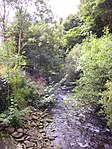The Cymmer Colliery explosion occurred in the early morning of 15 July 1856 at the Old Pit mine of the Cymmer Colliery near Porth (lower Rhondda Valley), Wales, operated by George Insole & Son. The underground gas explosion resulted in a "sacrifice of human life to an extent unparalleled in the history of coal mining of this country": 141 in which 114 men and boys were killed. Thirty-five widows, ninety-two children, and other dependent relatives were left with no immediate means of support.
The immediate cause of the explosion was defective mine ventilation and the use of naked flames underground. Factors contributing to the explosion included the rapid development of the mine to meet increased demand for coal, poor mine safety practices allowed by management despite official warnings, and deteriorating working relationships between miners and management.
After the explosion, mine owner James Harvey Insole and his officials were accused of "neglecting the commonest precautions for the safety of the men and the safe working of the colliery".: 2 At the coroner's inquest into the deaths, Insole deflected responsibility onto his mine manager Jabez Thomas and the jury brought a charge of manslaughter against Thomas and the four other mine officials. To the outrage of the local mining communities, the subsequent criminal proceedings resulted in the exoneration of the mine officials from any blame for the disaster.
The Cymmer Colliery disaster influenced the introduction of mine safety improvements including legislation for improved mine ventilation and the use of safety lamps, employment of children, and qualifications of mine officials. The tragedy highlighted the need for a workable compensation scheme for miners and their dependents to reduce their reliance on public charity after such disasters.









